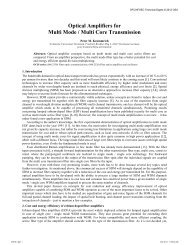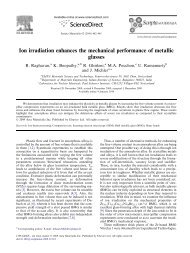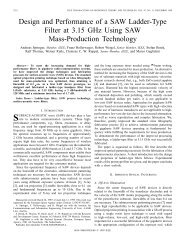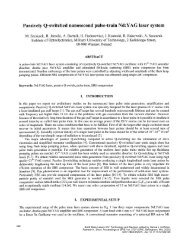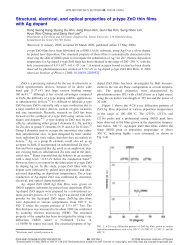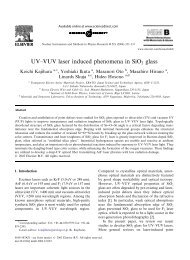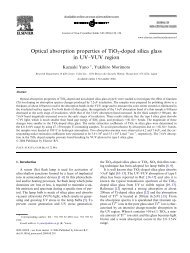Variant selection of primary, secondary and tertiary twins in a ...
Variant selection of primary, secondary and tertiary twins in a ...
Variant selection of primary, secondary and tertiary twins in a ...
Create successful ePaper yourself
Turn your PDF publications into a flip-book with our unique Google optimized e-Paper software.
2044 S. Mu et al. / Acta Materialia 60 (2012) 2043–2053<br />
that neutralize or <strong>of</strong>fset the macroscopic stress <strong>and</strong> <strong>in</strong> this<br />
way prevent potential <strong>tw<strong>in</strong>s</strong> with high macroscopic SFs<br />
from form<strong>in</strong>g. Conversely, when accommodation is easy<br />
[1,4], the <strong>in</strong>duced <strong>in</strong>ternal stresses are small <strong>and</strong> even low<br />
macroscopic SFs are sufficient to produce <strong>tw<strong>in</strong>s</strong>. These<br />
concepts have been employed <strong>in</strong> crystal level models to<br />
account for variant <strong>selection</strong> dur<strong>in</strong>g tw<strong>in</strong>n<strong>in</strong>g. Therefore,<br />
while detailed quantitative underst<strong>and</strong><strong>in</strong>g is still lack<strong>in</strong>g,<br />
<strong>in</strong> part because <strong>of</strong> the <strong>in</strong>homogeneous nature <strong>of</strong> the localized<br />
stra<strong>in</strong> fields, it has been possible to model some <strong>of</strong><br />
the effects <strong>of</strong> these fields [6–8].<br />
The accommodation stra<strong>in</strong>s <strong>in</strong>duced by tw<strong>in</strong>n<strong>in</strong>g are<br />
generally relaxed by slip or tw<strong>in</strong>n<strong>in</strong>g <strong>in</strong> the adjo<strong>in</strong><strong>in</strong>g gra<strong>in</strong><br />
[9,10]. These stra<strong>in</strong>s can be evaluated by rotat<strong>in</strong>g the tw<strong>in</strong>n<strong>in</strong>g<br />
shear displacement gradient tensor <strong>in</strong>to the crystallographic<br />
frame <strong>of</strong> the neighbor<strong>in</strong>g gra<strong>in</strong>. The analysis <strong>of</strong> this<br />
phenomenon <strong>in</strong>volves three sets <strong>of</strong> reference frames: (i) the<br />
tw<strong>in</strong>n<strong>in</strong>g system frame; (ii) the crystallographic frame <strong>of</strong><br />
the matrix; <strong>and</strong> (iii) the crystallographic frame <strong>of</strong> the neighbor<strong>in</strong>g<br />
gra<strong>in</strong>. Details <strong>of</strong> the manipulations required are<br />
described <strong>in</strong> Ref. [4].<br />
Each <strong>of</strong> the accommodation stra<strong>in</strong> tensor components e ij<br />
(where i is the shear direction <strong>and</strong> j is the shear plane) can <strong>in</strong><br />
turn be given a physical <strong>in</strong>terpretation <strong>in</strong> terms <strong>of</strong> the dislocation<br />
or tw<strong>in</strong>n<strong>in</strong>g mechanism <strong>in</strong>volved: (i) the e zx <strong>and</strong> e zy<br />
components correspond to accommodation by means <strong>of</strong><br />
tw<strong>in</strong>n<strong>in</strong>g or pyramidal hc + ai slip (here y is parallel to<br />
one <strong>of</strong> the basal glide Burgers vectors, i.e. to the ½1 1 20Š<br />
direction; z is perpendicular to the basal plane; <strong>and</strong> x is<br />
mutually perpendicular to both, follow<strong>in</strong>g the right-h<strong>and</strong><br />
rule); (ii) the e yz <strong>and</strong> e xz shears can be respectively accommodated<br />
by s<strong>in</strong>gle or double basal glide; (iii) the e yx correspond<br />
to s<strong>in</strong>gle prismatic glide <strong>and</strong> the e xy correspond to<br />
balanced glide on the two rema<strong>in</strong><strong>in</strong>g prism planes. (Note<br />
that the present reference frame differs slightly from that<br />
employed <strong>in</strong> Ref. [4], <strong>in</strong> that it has been rotated by 90° about<br />
the z-axis.)<br />
Among the five possible deformation modes (three slip<br />
<strong>and</strong> two tw<strong>in</strong>n<strong>in</strong>g), basal slip <strong>and</strong> extension tw<strong>in</strong>n<strong>in</strong>g can<br />
be activated with relative ease due to their low associated<br />
critical resolved shear stresses. As a result, the magnitude<br />
<strong>of</strong> the <strong>in</strong>duced back or <strong>in</strong>ternal stress is small <strong>and</strong> there is<br />
little modification <strong>of</strong> the macroscopic SF. By contrast, prismatic<br />
slip has a critical resolved shear stress (CRSS) at least<br />
an order <strong>of</strong> magnitude higher than those <strong>of</strong> basal slip <strong>and</strong><br />
extension tw<strong>in</strong>n<strong>in</strong>g at ambient temperatures [11]. Moreover,<br />
no alternative mechanism is available to provide the<br />
deformation components (e xy <strong>and</strong> e yx ) produced by prismatic<br />
slip. In this case, very large localized back-stresses will<br />
be developed, which will tend to oppose the macroscopic<br />
SF. Therefore, when a potential tw<strong>in</strong> variant requires a<br />
large amount <strong>of</strong> prismatic glide <strong>in</strong> the neighbor<strong>in</strong>g gra<strong>in</strong>,<br />
the nucleation <strong>of</strong> this variant will be rather difficult even if<br />
the nom<strong>in</strong>al SF is relatively high [4].<br />
The large differences <strong>in</strong> the energy required to accommodate<br />
the various potential tw<strong>in</strong> variants have been employed<br />
to expla<strong>in</strong> non-Schmid variant <strong>selection</strong> dur<strong>in</strong>g <strong>secondary</strong><br />
extension [1] <strong>and</strong> <strong>primary</strong> contraction [4] tw<strong>in</strong>n<strong>in</strong>g <strong>in</strong> Mg<br />
alloys AZ31 <strong>and</strong> AM30. In the current work, we extend this<br />
type <strong>of</strong> variant <strong>selection</strong> analysis to the nucleation <strong>and</strong><br />
growth <strong>of</strong> <strong>primary</strong> ETWs <strong>in</strong> Mg alloys as well as to that<br />
<strong>of</strong> the two generations <strong>of</strong> <strong>tw<strong>in</strong>s</strong> that follow. That is, we test<br />
the accommodation stra<strong>in</strong> hypothesis on three further types<br />
<strong>of</strong> <strong>tw<strong>in</strong>s</strong> <strong>in</strong> addition to those <strong>of</strong> Refs. [1,4]. We therefore<br />
consider further the relative importance <strong>of</strong> the macroscopic<br />
Schmid factor on the one h<strong>and</strong> <strong>and</strong> the accommodation<br />
stra<strong>in</strong> (<strong>and</strong> <strong>in</strong>duced <strong>in</strong>ternal stress) on the other.<br />
In the current <strong>in</strong>vestigation, samples <strong>of</strong> Mg alloy AZ31<br />
were deformed <strong>in</strong> plane stra<strong>in</strong> compression (PSC) to stra<strong>in</strong>s<br />
<strong>in</strong> the range between 0.02 <strong>and</strong> 0.2 at 100 °C. Most <strong>of</strong><br />
the gra<strong>in</strong>s were <strong>in</strong>itially favorably oriented for extension<br />
tw<strong>in</strong>n<strong>in</strong>g. Copious ETWs were formed on load<strong>in</strong>g <strong>and</strong> progressively<br />
replaced the start<strong>in</strong>g microstructure by the time a<br />
stra<strong>in</strong> <strong>of</strong> 0.08 was atta<strong>in</strong>ed. As deformation was extended<br />
beyond 0.08, many <strong>secondary</strong> CTWs formed with<strong>in</strong> the <strong>primary</strong><br />
ETWs. At a stra<strong>in</strong> <strong>of</strong> about 0.10, some <strong>tertiary</strong><br />
ETWs were generated <strong>in</strong>side the <strong>secondary</strong> CTWs. F<strong>in</strong>ally,<br />
when stra<strong>in</strong>s beyond 0.13 were applied, the CTWs were<br />
almost completely replaced by the <strong>tertiary</strong> <strong>tw<strong>in</strong>s</strong>. The orientations<br />
<strong>of</strong> all three generations <strong>of</strong> <strong>tw<strong>in</strong>s</strong> were determ<strong>in</strong>ed<br />
by electron backscatter diffraction (EBSD) techniques.<br />
In what follows, the results obta<strong>in</strong>ed at a stra<strong>in</strong> <strong>of</strong> 0.11<br />
are exam<strong>in</strong>ed <strong>in</strong> detail. This stra<strong>in</strong> was chosen because all<br />
three generations <strong>of</strong> <strong>tw<strong>in</strong>s</strong> could be readily dist<strong>in</strong>guished.<br />
The orientations <strong>and</strong> SFs <strong>of</strong> both the observed <strong>tw<strong>in</strong>s</strong> as<br />
well as all potential tw<strong>in</strong> variants were calculated. Both<br />
the values <strong>of</strong> the macroscopic Schmid factors <strong>and</strong> the<br />
accommodation stra<strong>in</strong> hypothesis were then employed to<br />
account for the variant <strong>selection</strong> observed dur<strong>in</strong>g the nucleation<br />
<strong>and</strong> growth <strong>of</strong> the three generations <strong>of</strong> <strong>tw<strong>in</strong>s</strong>. In order<br />
to calculate the accommodation stra<strong>in</strong>s that the tw<strong>in</strong> variants<br />
were try<strong>in</strong>g to impose on their neighbor<strong>in</strong>g gra<strong>in</strong>s, the<br />
orientations <strong>of</strong> all adjacent gra<strong>in</strong>s were also measured.<br />
Here, only the neighbors observed <strong>in</strong> the 2-D sections were<br />
considered <strong>and</strong> the neighbors located above <strong>and</strong> below the<br />
plane <strong>of</strong> section were not taken <strong>in</strong>to account. Nevertheless,<br />
new methods, both destructive <strong>and</strong> non-destructive, for<br />
measur<strong>in</strong>g aspects <strong>of</strong> 3-D microstructures <strong>in</strong> bulk polycrystals<br />
are becom<strong>in</strong>g more common. Some <strong>of</strong> these methods<br />
allow for more direct measurement <strong>of</strong> aspects <strong>of</strong> tw<strong>in</strong> formation<br />
[12,13].<br />
2. Experimental<br />
The as-received material was the commercial wrought<br />
Mg alloy AZ31B (3.33 wt.% Al <strong>and</strong> 1 wt.% Zn) <strong>in</strong> the<br />
as-cast condition. The <strong>in</strong>got was first rolled at 400 °C for<br />
several passes up to 50% thickness reduction. It was then<br />
annealed at 400 °C for 12 h to produce an appropriate<br />
microstructure <strong>and</strong> the desired <strong>in</strong>itial texture. The result<strong>in</strong>g<br />
material was fully recrystallized with an average gra<strong>in</strong> size<br />
<strong>of</strong> about 25 lm, free <strong>of</strong> mechanical <strong>tw<strong>in</strong>s</strong>. The texture after<br />
anneal<strong>in</strong>g was measured by conventional X-ray techniques.<br />
The (0002) pole figure (PF) exhibited a well-def<strong>in</strong>ed basal




